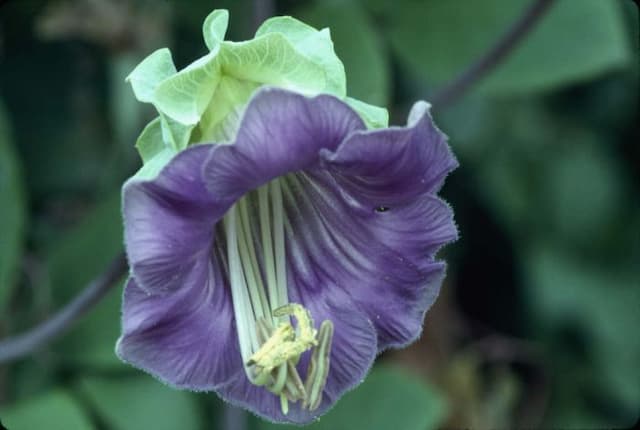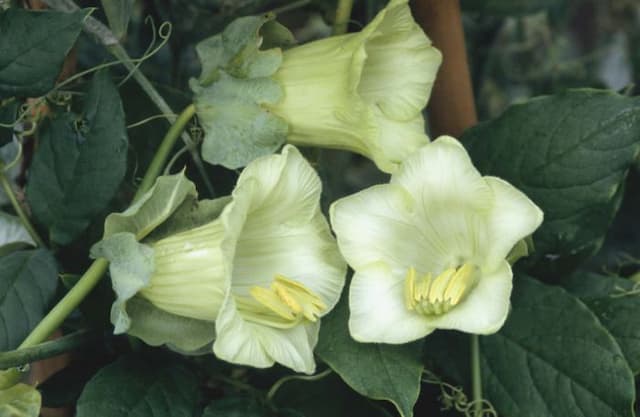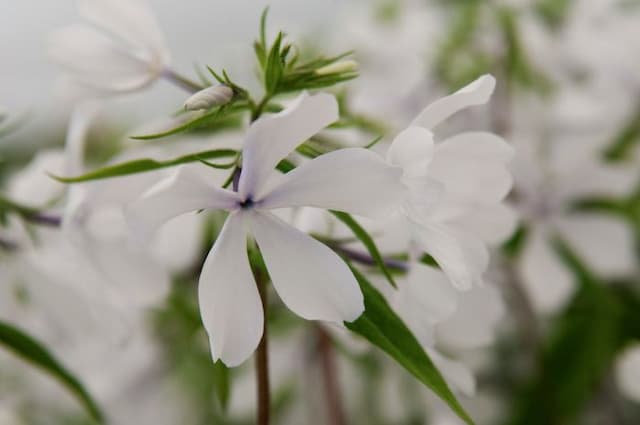Jacob's Ladder Polemonium 'Lambrook Mauve'

ABOUT
Polemonium 'Lambrook Mauve', commonly known as Jacob's ladder, is a perennial plant that boasts a visually appealing appearance due to its distinctive foliage and flowers. Its leaves are often pinnately divided, creating a ladder-like effect, which is where its common name derives. This foliage typically exhibits a lush green color which serves as a lovely backdrop to the flowers. The flowers of Jacob's ladder 'Lambrook Mauve' are its most striking feature. They tend to be bell-shaped and form in clusters atop the foliage. These blooms have a soft, pastel mauve color that lends a gentle yet alluring quality to the plant's aesthetic. The petals of each flower are slightly fused at the base, creating a delicate skirt that may flutter in the breeze. Overall, the combination of the finely textured leaves and the subtle hue of the flowers result in a plant that exudes a sense of grace and elegance in a garden setting. It's particularly favored by gardeners who wish to introduce a touch of whimsy and soothing color tones to their landscape.
About this plant
 Names
NamesFamily
Polemoniaceae.
Synonyms
Jacob's Ladder, Greek Valerian, Charity.
Common names
Polemonium 'Lambrook Mauve'.
 Toxicity
ToxicityTo humans
Jacob's ladder, commonly known as Polemonium 'Lambrook Mauve', is not known to be highly toxic to humans. However, like many plants, it may cause mild gastrointestinal discomfort if ingested. It is advisable not to consume any part of ornamental plants generally, as they are not intended for human consumption. If symptoms such as nausea, vomiting, or diarrhea occur after ingestion, it is important to seek medical attention.
To pets
Jacob's ladder, commonly known as Polemonium 'Lambrook Mauve', is not widely recognized as a toxic plant to pets such as dogs and cats. However, ingestion of plant material can sometimes lead to mild gastrointestinal upset in animals, which could include symptoms such as vomiting or diarrhea. It is always best to prevent pets from consuming plants that are not explicitly intended for animal consumption to avoid any potential adverse reactions. If you suspect your pet has ingested a significant amount of the plant and is showing signs of distress, it is important to contact your veterinarian.
 Characteristics
CharacteristicsLife cycle
Perennials
Foliage type
Deciduous
Color of leaves
Green
Flower color
Mauve
Height
1-2 feet (30-60 cm)
Spread
1-2 feet (30-60 cm)
Plant type
Herb
Hardiness zones
3
Native area
North America
Benefits
 General Benefits
General Benefits- Attracts pollinators: The flowers of Jacob's Ladder attract bees and butterflies, which are beneficial for pollination of surrounding plants.
- Ease of care: Jacob's Ladder is a low-maintenance perennial, making it a good choice for gardeners of all skill levels.
- Aesthetic appeal: With its mauve flowers and attractive foliage, Jacob's Ladder adds beauty and visual interest to gardens.
- Seasonal interest: It typically blooms in late spring to early summer, providing seasonal color when many other plants are not yet in bloom.
- Tolerates various conditions: Jacob's Ladder is adaptable to a range of soil conditions and can grow in both full sun and partial shade.
- Height variation: As a medium-sized plant, it can be used to create tiered effects in garden design, fitting in well with both low-growing plants and taller species.
- Non-invasive: It typically does not spread aggressively, which helps maintain the intended design of a garden.
- Companion planting: It pairs well with other shade-loving perennials like hostas and ferns, allowing for complementary garden compositions.
 Medical Properties
Medical PropertiesThis plant is not used for medical purposes.
 Air-purifying Qualities
Air-purifying QualitiesThis plant is not specifically known for air purifying qualities.
 Other Uses
Other Uses- Polemonium 'Lambrook Mauve', commonly known as Jacob's Ladder, can be used in dried flower arrangements once the blooms have faded, as the seed heads can add texture and interest to the display.
- In a sensory garden, the delicate foliage and flowers of Jacob's Ladder can provide a gentle visual stimulus and the leaves are sometimes used for their interesting ladder-like appearance.
- Jacob's Ladder can be used as a natural dye source; the flowers, when processed, can yield soft, mauve-tinted dyes suitable for fabrics or crafting materials.
- The plant can serve an educational purpose, demonstrating the lifecycle of perennials in a school garden or as part of botany lessons with its distinct blooming habit.
- The plant's structure can offer a miniature habitat or shelter for beneficial insects like ladybugs and bees when it's incorporated into a wildlife garden.
- In photography, the striking formation of the leaves and the pastel color of the flowers of Jacob's Ladder can provide a picturesque background or subject in garden photography.
- Gardeners can use the clumping growth habit of Jacob's Ladder as a natural border to define garden paths or edge garden beds without the need for artificial barriers.
- As part of a moon garden, the light-colored flowers of Jacob's Ladder are particularly reflective and can add subtle luminosity in the evening.
- The plant, due to its moderate height, can be used in layering techniques for garden design, fitting well between shorter ground covers and taller backdrop plants.
- Creative crafters sometimes use the intricate foliage and flowers of Jacob's Ladder in pressed flower art, a traditional practice to create natural, botanical designs on paper or fabric.
Interesting Facts
 Feng Shui
Feng ShuiThe Jacob's Ladder is not used in Feng Shui practice.
 Zodiac Sign Compitability
Zodiac Sign CompitabilityThe Jacob's Ladder is not used in astrology practice.
 Plant Symbolism
Plant Symbolism- Healing: Polemonium, commonly known as Jacob's Ladder, is often associated with healing due to its medicinal properties that have been recognized in traditional medicine.
- Ascension: The name Jacob's Ladder is biblically inspired, referring to the dream of the biblical patriarch Jacob, where a ladder or staircase extended to heaven. It symbolizes the path to enlightenment or the journey from earthly matters to higher spiritual planes.
- Connection with angels: The steps of the ladder in the name Jacob's Ladder represent the connection between the divine and humans, suggesting a bridge between realms or the possibility of angelic communication.
- Peace: The delicate and harmonious arrangement of the plant’s leaves and flowers are often perceived as symbols of tranquility and peace.
- Humility: The modest yet beautiful appearance of Jacob's Ladder can symbolize humility, gentleness, and modesty in various cultural contexts.
 Water
WaterJacob's Ladder should be watered thoroughly once a week, allowing the top inch of soil to dry out before the next watering. During hot or dry spells, you may need to water more frequently, perhaps every few days, to maintain consistent soil moisture. Use about one gallon of water per plant for each watering to ensure deep soil penetration. In cooler seasons or during periods of rainfall, reduce watering to prevent waterlogging. Overwatering can lead to root rot, so it's important to let the soil dry slightly between waterings.
 Light
LightJacob's Ladder thrives in partial to full shade, making it an excellent choice for shaded gardens or areas under trees. Avoid placing it in full sun, which can lead to leaf scorch. The ideal spot for Jacob's Ladder is in dappled sunlight or a location where it receives morning light and afternoon shade, ensuring it is protected during the hottest part of the day.
 Temperature
TemperatureJacob's Ladder prefers a temperate climate and does well in temperatures ranging from 50°F to 75°F. It can survive minimum temperatures down to about 40°F but should be protected from frost. During extreme heat, above 85°F, the plant might show signs of stress; hence, it's crucial to provide adequate shade and water. Ideal temperatures for optimal growth are between 60°F and 70°F.
 Pruning
PruningJacob's Ladder benefits from pruning to remove spent flowers and encourage bushier growth. Prune immediately after the first bloom to promote a second flush of flowers. Cut back the stalks by about one-third. At the end of the flowering season, or in late fall, prune the plant down to its base to tidy up and prepare for winter. Pruning can be done annually.
 Cleaning
CleaningAs needed
 Soil
SoilJacob's Ladder 'Lambrook Mauve' thrives in well-draining, humus-rich soil with a pH range of 6.0 to 7.5. A good soil mix would consist of garden soil, compost, and perlite to enhance drainage. Amend with organic matter to provide essential nutrients and maintain soil health.
 Repotting
RepottingJacob's Ladder 'Lambrook Mauve' typically doesn't require frequent repotting and can be done every 2-3 years or when the plant outgrows its current pot. Repot in the spring before the onset of the new growth period.
 Humidity & Misting
Humidity & MistingJacob's Ladder 'Lambrook Mauve' prefers moderate humidity levels but is quite adaptable. Aim to maintain humidity around 40-50% for optimal growth, avoiding environments that are too dry or too damp.
 Suitable locations
Suitable locationsIndoor
Provide bright, indirect light and consistent moisture.
Outdoor
Place in part shade, mulch, and water regularly.
Hardiness zone
4-8 USDA
 Life cycle
Life cyclePolemonium 'Lambrook Mauve', commonly known as Jacob's Ladder, begins its life as a seed, which, when sown in fertile, well-draining soil and with proper moisture, will germinate. After germination, the plant develops into a seedling with characteristic ladder-like leaf arrangements. As it enters the vegetative stage, Polemonium 'Lambrook Mauve' starts to establish a more extensive root system and grows taller, with the stems and foliage becoming more robust. During its flowering stage, usually in late spring or early summer, it produces clusters of bell-shaped mauve flowers that are attractive to pollinators. After pollination, the flowers develop into seed capsules, which eventually dry and release new seeds, completing the reproductive cycle. In colder climates, the plant may die back in winter, entering a period of dormancy, before resurging in the spring if it's a perennial variety.
 Propogation
PropogationPropogation time
Spring-Early Summer
The Polemonium 'Lambrook Mauve', commonly known as Jacob's Ladder, is most effectively propagated from seeds. The best time to sow these seeds is either in spring or autumn. To propagate by seed, surface sow the seeds onto a well-drained seed starting mix, barely covering them with soil. It's important to maintain moisture but avoid waterlogging. Seeds usually germinate within 21 to 30 days at temperatures around 70°F (21°C). Once seedlings have developed true leaves and are large enough to handle, they can be transplanted into pots and later into the garden, spaced about 12 to 18 inches (30 to 45 centimeters) apart to allow for adequate growth. Seed propagation is considered the easiest and most common method for this perennial plant.









